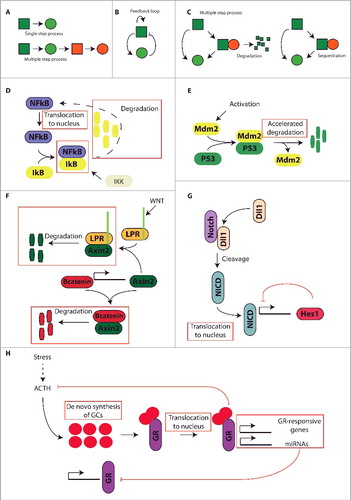Figures & data
Figure 1. Different molecular mechanisms that can induce time-delay necessary for the generation of oscillations in transcription factor activity. A) Inclusion of multiple intermediate steps that take a minimum amount of time, such as transcription, translation, transportation; B) Inclusion of a threshold concentration, in the form of a feedback loop that generates an on/off-like response, necessary for a molecule to become biologically active; C) Inclusion of degradation/sequestration steps that prevent functionality. Examples are: inclusion of a saturated degradation step or inclusion of a complex sequestration step; D) The NFkB pathway is regulated by the sequestration of NFkB by IkB, rendering NFkB inaccessible. Only upon phosphorylation of IkB by IKK, IkB is degraded and NFkB becomes functionally active; E) Oscillatory behavior is generated by the P53-induced transcription of Mdm2, which in turn binds to P53 and results in accelerated degradation of P53; F) Axin2 governs at least a part of the oscillatory behavior of the Wnt pathway. Axin2 transcription is under control of B-catenin, and upon translation Axin2 can either bind B-catenin, inducing degradation, or bind the LRP receptor complex inducing degradation of Axin2 itself; G) A negative feedback loop controls oscillations in the Notch signaling pathway. Upon stimulation of the Notch receptors they are cleaved and their intracellular domain, NICD, is translocated to the nucleus where it promotes the expression of Hes1. Hes1 in its turn inhibits its own promotor, thereby creating a negative feedback loop; H) Glucocorticoid signaling is a prime example of several time-delay steps inducing oscillations. First, glucocorticoids are synthesized de novo upon stimulation by ACTH. Upon release, glucocorticoids bind to and activate the GR, the activated glucocorticoid receptor is translocated to the nucleus where it induces the transcription of several GR-responsive protein coding genes, as well as several microRNAs. Some of these microRNAs form negative feedback loops with the GR, locally inhibiting GR expression. Furthermore, the activated GR is engaged in a classic negative feedback loop to the brain, where it inhibits the production of ACTH and other upstream mediators of the HPA axis.

